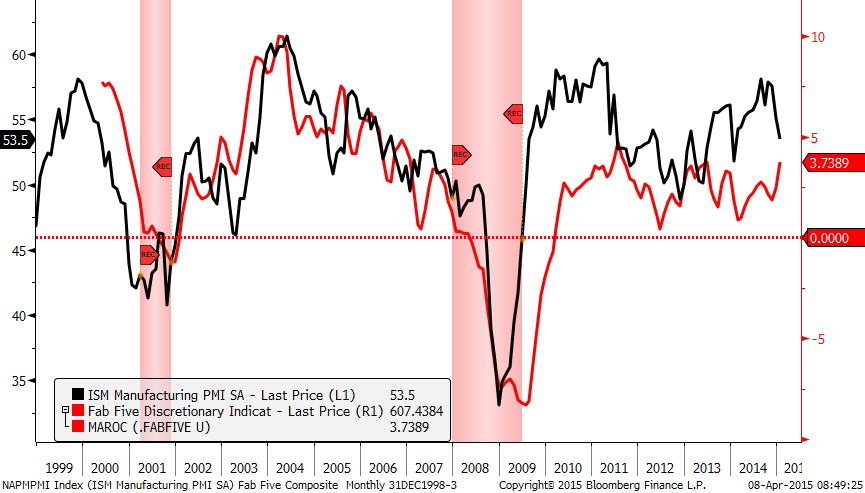In an interview we posted yesterday, Michael “Mish” Shedlock of Global Economic Trend Analysis told listeners, “I think it’s possible the U.S. is in recession right now…or, at the very least, we are on the cusp of one,” and cited a long list of weak economic numbers, including the Atlanta Fed GDPNow model showing no growth (see here), as evidence.
Since bear markets and U.S. recessions often go together, it is important to monitor whether in fact economic data is deteriorating and no longer supportive of a bull market in stocks.
So what does the data tell us?
Chris Puplava, a regular contributor to Financial Sense and a portfolio manager at PFS Group, supplied me with the following 5 charts (he has plenty more, but I said 5 was probably enough) to make the case that the U.S. is not about to fall into recession...at least probably not until 2016 at the earliest. (By the way, another important area he watches closely for signs of trouble is financial stress. For those of you that like charts and data, you may wish to read his recent piece, “Financial Stress Is Rising – Time to Worry?” as well.)
PFS Group Recession Model at 2%
The first chart Chris sent me is his recession probability indicator, which aggregates a number of economic metrics into one nice-easy-to-read graph. As of today, it shows a 2% probability the U.S. is in recession. He says you want to start worrying as you get closer to the 20% threshold, which has been fairly accurate in signaling the onset of bear markets from a major economic slowdown (in all charts below red vertical bars denote recessions).
Conference Board Leading Economic Index
Another measure we follow and also cite quite often on the show is the Conference Board Leading Economic Index, which includes ten components covering a wide swath of the U.S. economy and other important metrics that tend to turn downward before recessions. Because of how many areas it covers (manufacturing, weekly jobless claims, building permits, interest rate spreads, consumer expectations, etc.) it has proved very reliable at forecasting recessions and is currently resting comfortably in positive territory.
Consumer Spending on the “Fab Five”
Bloomberg’s Senior Economist Rich Yamarone has compiled what he calls his “Fab Five” indicators of consumer discretionary items—jewelry, gambling, dining out, women’s clothing, and cosmetics—things that consumers will spend more or less money on depending on the state of the economy.
The most reliable and sensitive of the five he says in this video is women’s clothing because “the woman is the CFO of the household” and the first to either cut back on new purchases or, conversely, to buy a new dress when things improve. As you can see below, this category (shown in pink—what else!) is the second strongest just behind gambling. The third strongest is dining out, which Yamarone says is the next most important indicator to watch for whether the economy is improving or showing signs of decline. Both of these are climbing.
Since the above is a little messy, here’s a composite of all five (in red). The overall trend is upward and not showing any warning signs of consumers cutting back on these highly sensitive areas. Also shown is manufacturing (in black), which has recently diverged from its close correlation to the “fab five” due in part to a stronger dollar. Keep in mind, consumer spending accounts for a much larger percentage of the economy than manufacturing, though it bears watching nonetheless.
Employment Trends
One cannot discuss the likelihood of a recession without some mention of employment trends. Two important indicators most analysts watch on this front are the U3 unemployment rate and the 4-week moving average of jobless claims. In both cases, these economic indicators are resting comfortably below recessionary-warning levels (see red dotted lines) and have yet to raise a red flag.
On Friday, we'll be speaking with Neil Dutta, Head of U.S. Economics at Renaissance Macro, who'll be sharing his insights on the state of the economy, the U.S. stock market, and abroad. We highly encourage our subscribers to tune into that interview for additional perspective.
If you are not a subscriber and would like to hear our recent interview with Michael Shedlock or our upcoming interview with Neil Dutta, please click here to gain complete access to all of our broadcasts with top financial commentators, analysts, and market strategists.











